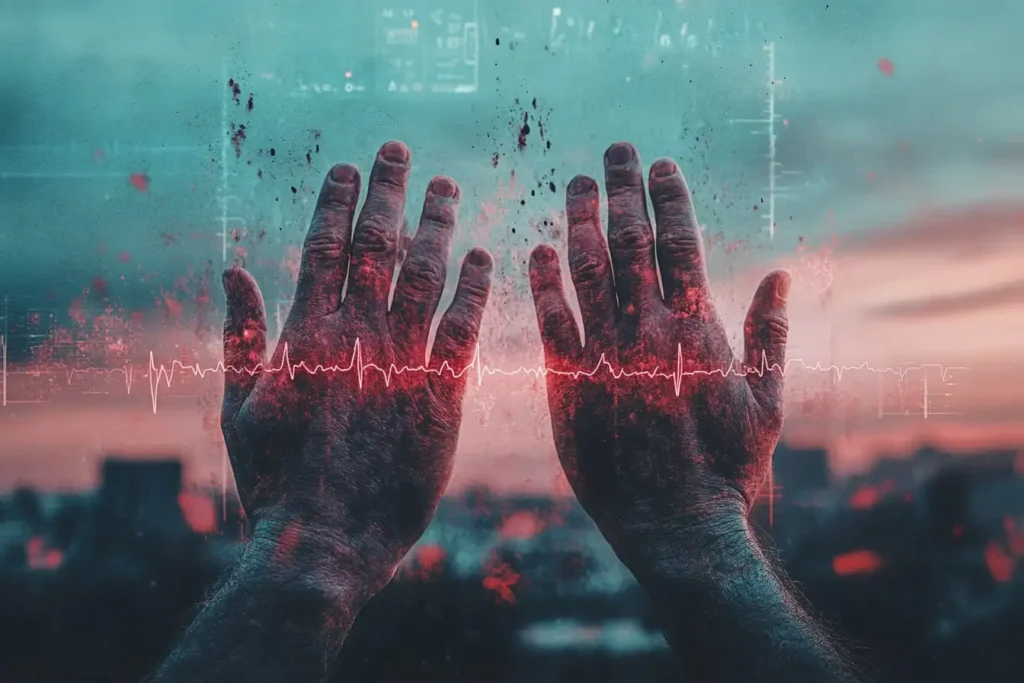When your heart races, your chest tightens, and you feel like the world is closing in, it’s easy to assume the worst. Are you having a heart attack, or is it a panic attack? Understanding the differences between heart attack and panic attack symptoms can be life-saving. While both conditions share some similarities, they are fundamentally different in terms of causes, severity, and treatment.
The confusion between a heart attack or panic attack is common because symptoms like chest pain, shortness of breath, and sweating can occur in both. However, mistaking one for the other can have serious consequences. This guide will help you recognize the key differences, understand the symptoms, and know what to do in an emergency.
What is a Heart Attack?
A heart attack, medically known as a myocardial infarction, is a life-threatening event that occurs when the blood supply to a part of the heart muscle is suddenly blocked. Without oxygen-rich blood, the affected heart tissue begins to die, leading to permanent damage or even death if not treated promptly.
The heart is a vital organ that relies on a constant supply of oxygen and nutrients delivered through the coronary arteries. When one or more of these arteries become blocked, the heart muscle is starved of oxygen, triggering a heart attack. This blockage is most commonly caused by a blood clot that forms in a narrowed or damaged artery.

Causes of a Heart Attack
Heart attacks are primarily caused by conditions that restrict or block blood flow to the heart. The most common causes include:
- Coronary Artery Disease (CAD):
- This is the leading cause of heart attacks. CAD occurs when the coronary arteries, which supply blood to the heart, become narrowed or blocked due to a buildup of fatty deposits called plaque. Over time, this plaque can harden or rupture, leading to the formation of a blood clot that blocks blood flow.
- Blood Clots:
- When plaque in the coronary arteries ruptures, the body responds by forming a blood clot to repair the damage. However, this clot can completely block the artery, cutting off blood flow to the heart muscle.
- Coronary Artery Spasms:
- In some cases, the coronary arteries can suddenly tighten or spasm, reducing blood flow to the heart. These spasms can occur in arteries with or without plaque buildup and are often triggered by stress, smoking, or drug use.
- Other Causes:
- Rarely, a heart attack can be caused by a tear in the coronary artery (spontaneous coronary artery dissection) or a condition that reduces blood flow, such as severe anemia or extremely low blood pressure.
Why Heart Attacks Are Medical Emergencies
A heart attack is a medical emergency that requires immediate attention. Every minute counts because the longer the heart muscle is deprived of oxygen, the greater the damage. Delaying treatment can lead to:
- Permanent heart muscle damage
- Heart failure
- Life-threatening arrhythmias (irregular heartbeats)
- Death
Recognizing the symptoms and seeking help quickly can significantly improve the chances of survival and recovery.
Key Takeaways
- A heart attack occurs when blood flow to the heart is blocked, usually by a blood clot.
- The most common cause is coronary artery disease, which leads to plaque buildup in the arteries.
- Heart attacks are medical emergencies that require immediate treatment to prevent severe complications or death.
If you or someone around you experiences symptoms like chest pain, shortness of breath, or cold sweats, call emergency services immediately. Acting fast can save a life.at require immediate attention. Delaying treatment can lead to severe complications or even death.
What is a Panic Attack?
A panic attack is an overwhelming and sudden surge of intense fear or anxiety that triggers severe physical and emotional reactions, even in the absence of any real danger. These episodes can feel terrifying, often leaving the individual feeling out of control or as though they are facing a life-threatening situation. While panic attacks are not physically life-threatening, they can be deeply distressing and disruptive to daily life.
Panic attacks are a hallmark symptom of panic disorder, but they can also occur in other anxiety disorders or even in individuals without a diagnosed mental health condition. Understanding what a panic attack is, what causes it, and how it manifests can help demystify the experience and encourage those affected to seek appropriate support.

What Happens During a Panic Attack?
During a panic attack, the body’s fight-or-flight response is activated, even though there is no actual threat. This response floods the body with stress hormones like adrenaline, leading to a cascade of physical and emotional symptoms. These symptoms often peak within minutes and can include:
- Rapid heartbeat or palpitations
- Shortness of breath or hyperventilation
- Chest pain or discomfort
- Trembling or shaking
- Sweating or chills
- Dizziness or lightheadedness
- Nausea or stomach distress
- A sense of impending doom or fear of dying
- Feelings of detachment from reality or oneself
The intensity of these symptoms can make a panic attack feel like a heart attack or another serious medical condition, which often adds to the fear and confusion.
Causes of a Panic Attack
Panic attacks can be triggered by a variety of factors, and their causes are often complex and interconnected. Here are some of the most common causes:
- Stress or Traumatic Events:
- High levels of stress, whether from work, relationships, or major life changes, can increase the likelihood of panic attacks. Traumatic events, such as accidents, abuse, or the loss of a loved one, can also trigger them.
- Anxiety Disorders:
- Panic attacks are a key symptom of panic disorder, but they can also occur in other anxiety-related conditions, such as generalized anxiety disorder (GAD), social anxiety disorder, or post-traumatic stress disorder (PTSD).
- Medical Conditions:
- Certain medical conditions, such as thyroid disorders, heart arrhythmias, or respiratory issues, can mimic or trigger panic attack symptoms. It’s important to rule out underlying medical causes.
- Medications or Substances:
- Some medications, particularly stimulants or those that affect the nervous system, can trigger panic attacks. Additionally, substances like caffeine, alcohol, or recreational drugs can increase the risk.
- Genetic and Biological Factors:
- A family history of anxiety or panic disorders can predispose individuals to panic attacks. Imbalances in brain chemicals, such as serotonin or norepinephrine, may also play a role.
Why Panic Attacks Are Not Life-Threatening
While panic attacks can feel overwhelmingly frightening, they are not physically dangerous. The symptoms, though intense, are a result of the body’s natural stress response and do not cause harm on their own. However, the fear of having another panic attack can lead to a cycle of anxiety, avoidance behaviors, and a significant impact on quality of life.
The Impact of Panic Attacks on Daily Life
Even though panic attacks are not physically harmful, they can have profound effects on an individual’s well-being:
- Emotional Distress: The fear of experiencing another panic attack can lead to chronic anxiety or depression.
- Avoidance Behaviors: Individuals may avoid places, situations, or activities they associate with previous panic attacks, limiting their ability to live fully.
- Social and Professional Challenges: Panic attacks can interfere with relationships, work performance, and daily responsibilities.
When to Seek Professional Help
If panic attacks are frequent, severe, or interfering with your ability to function, it’s important to seek professional treatment. Effective treatments include:
- Therapy: Cognitive-behavioral therapy (CBT) is particularly effective in helping individuals understand and manage panic attacks.
- Medication: Antidepressants or anti-anxiety medications may be prescribed to reduce the frequency and severity of attacks.
- Lifestyle Changes: Stress management techniques, regular exercise, and a healthy diet can help reduce the likelihood of panic attacks.
Key Takeaways
- A panic attack is a sudden episode of intense fear or anxiety that triggers severe physical and emotional reactions.
- Common causes include stress, anxiety disorders, medical conditions, and genetic factors.
- While panic attacks are not life-threatening, they can significantly impact quality of life and may require professional treatment.
If you or someone you know is experiencing panic attacks, reaching out to a mental health professional can provide the tools and support needed to manage and overcome this challenging condition.
Key Differences Between Heart Attack and Panic Attack Symptoms
Here’s a quick comparison to help you distinguish between a heart attack or panic attack:
| Symptom | Heart Attack | Panic Attack |
|---|---|---|
| Chest Pain | Pressure, squeezing, or fullness in the chest | Sharp, stabbing, or localized pain |
| Pain Radiation | Pain spreads to the arm, jaw, or neck | Pain remains in the chest |
| Shortness of Breath | Often occurs with chest pain | Can occur without chest pain |
| Sweating | Cold sweat | Hot flashes or sweating |
| Nausea | Common | Less common |
| Duration | Symptoms persist or worsen over time | Symptoms peak within 10-30 minutes |
Heart Attack Symptoms in Detail
Heart attack symptoms can vary between individuals, but here are the most common signs:
- Chest Pain: A feeling of pressure, tightness, or squeezing in the center of the chest.
- Pain Radiating to Other Areas: Discomfort that spreads to the arms (especially the left arm), jaw, neck, or back.
- Shortness of Breath: Difficulty breathing, often accompanied by chest pain.
- Cold Sweat: Sudden, unexplained sweating.
- Nausea or Vomiting: Feeling sick to your stomach or actually vomiting.
- Fatigue: Unusual tiredness, especially in women.
Less Common Symptoms in Women:
Women may experience atypical symptoms like indigestion, dizziness, or extreme fatigue. If you suspect a heart attack, seek emergency help immediately.
Panic Attack Symptoms in Detail
Panic attack symptoms can feel overwhelming, but they are not life-threatening. Common signs include:
- Rapid Heartbeat: A pounding or racing heart.
- Chest Pain: Sharp or stabbing pain that is localized.
- Trembling or Shaking: Uncontrollable shaking.
- Shortness of Breath: Feeling like you can’t catch your breath.
- Feeling of Doom: An intense fear of dying or losing control.
- Dizziness or Lightheadedness: Feeling faint or unsteady.
Panic attacks typically peak within 10-30 minutes and subside on their own. However, they can leave you feeling exhausted or fearful of another episode.
How to Tell the Difference: A Step-by-Step Guide
Distinguishing between a heart attack and a panic attack can be challenging because both conditions share similar symptoms, such as chest pain, shortness of breath, and sweating. However, understanding the key differences can help you respond appropriately in an emergency. If you’re unsure whether you’re experiencing a heart attack or panic attack, follow this step-by-step guide to assess the situation and take the right action.
1. Assess the Pain
The nature of the pain can provide important clues about whether you’re dealing with a heart attack or a panic attack.
- Heart Attack Pain:
- Often described as a feeling of pressure, squeezing, or fullness in the chest.
- The pain may radiate to other areas, such as the left arm, jaw, neck, or back.
- It typically feels like a heavy weight on the chest and may come and go or persist over time.
- Panic Attack Pain:
- Usually described as sharp, stabbing, or localized to one area of the chest.
- The pain does not radiate to other parts of the body.
- It may feel like a sudden, intense sensation that comes and goes quickly.
What to Do:
If the pain feels like pressure or squeezing and radiates to other areas, treat it as a potential heart attack and seek emergency help immediately.
2. Check for Additional Symptoms
Both heart attacks and panic attacks can cause a range of symptoms, but there are key differences to look for.
- Heart Attack Symptoms:
- Cold sweats: Sudden, unexplained sweating, often described as a “cold sweat.”
- Nausea or vomiting: Feeling sick to your stomach or actually vomiting.
- Shortness of breath: Difficulty breathing, especially when accompanied by chest pain.
- Fatigue: Unusual tiredness or weakness, particularly in women.
- Panic Attack Symptoms:
- Trembling or shaking: Uncontrollable shaking or trembling.
- Dizziness or lightheadedness: Feeling faint or unsteady.
- Rapid heartbeat: A pounding or racing heart.
- Sense of impending doom: An intense fear of dying or losing control.
What to Do:
If you’re experiencing cold sweats, nausea, or radiating pain, treat it as a potential heart attack. If your symptoms include trembling, dizziness, or a sense of doom, it may be a panic attack.
3. Consider the Triggers
Understanding what triggered the symptoms can help you determine whether it’s a heart attack or panic attack.
- Heart Attack Triggers:
- Often occur without warning or during physical exertion, such as exercise or heavy lifting.
- Can also happen during periods of extreme stress or emotional distress.
- Panic Attack Triggers:
- Often linked to stress, anxiety, or fear, such as public speaking, crowded spaces, or traumatic memories.
- Can occur in response to specific phobias or situations that provoke anxiety.
What to Do:
If the symptoms began during physical activity or without an obvious trigger, consider the possibility of a heart attack. If they occurred during a stressful or anxiety-provoking situation, it may be a panic attack.
4. Evaluate the Duration
The duration of symptoms can also help differentiate between a heart attack and a panic attack.
- Heart Attack Symptoms:
- Symptoms persist or worsen over time.
- Chest pain and discomfort do not go away on their own and may last for several minutes or longer.
- Panic Attack Symptoms:
- Symptoms peak within 10 minutes and typically subside within 20-30 minutes.
- After the attack, you may feel exhausted but otherwise physically normal.
What to Do:
If symptoms persist or worsen, treat it as a potential heart attack. If they peak and subside quickly, it may be a panic attack.
5. When to Seek Emergency Help
If you’re unsure whether you’re experiencing a heart attack or panic attack, always err on the side of caution. Here’s what to do:
- Call Emergency Services:
- Dial your local emergency number immediately. Do not delay seeking help.
- Stay Calm:
- Try to remain as calm as possible while waiting for help to arrive.
- Chew Aspirin (if advised):
- If you suspect a heart attack and are not allergic to aspirin, chewing one adult-sized aspirin (325 mg) may help.
- Inform Someone Nearby:
- Let someone know what’s happening so they can assist you if needed.
Key Takeaways
- Heart attack pain feels like pressure or squeezing and may radiate to other areas, while panic attack pain is sharp and localized.
- Heart attacks often involve cold sweats, nausea, and persistent symptoms, while panic attacks may include trembling, dizziness, and a sense of doom.
- Heart attacks can occur without warning or during physical exertion, while panic attacks are often triggered by stress or anxiety.
- Heart attack symptoms persist or worsen, while panic attack symptoms peak and subside within 30 minutes.
If you’re ever in doubt, seek emergency medical attention immediately. It’s better to be safe than sorry when it comes to your health.
Risk Factors for Heart Attacks and Panic Attacks
Understanding your risk factors can help you take preventive measures:
Heart Attack Risk Factors:
- Age (men over 45, women over 55)
- Smoking, high blood pressure, or high cholesterol
- Family history of heart disease
Panic Attack Risk Factors:
- History of anxiety or panic disorders
- High levels of stress or trauma
- Certain medical conditions or medications
What to Do If You’re Unsure: Emergency Steps
If you’re experiencing symptoms and aren’t sure if it’s a heart attack or panic attack, follow these steps:
- Call Emergency Services: Don’t wait to see if symptoms improve.
- Stay Calm: Try to remain as calm as possible while waiting for help.
- Chew Aspirin (if advised): If you suspect a heart attack, chewing an aspirin may help.
Prevention and Management Tips
Preventing Heart Attacks:
- Maintain a healthy diet and exercise regularly.
- Quit smoking and limit alcohol consumption.
- Monitor blood pressure and cholesterol levels.
Managing Panic Attacks:
- Practice relaxation techniques like deep breathing or meditation.
- Seek therapy or counseling for anxiety disorders.
- Consider medication if prescribed by a healthcare professional.
FAQs About Heart Attacks and Panic Attacks
1. Can a panic attack cause a heart attack?
No, but chronic stress and anxiety can increase your risk of heart disease over time.
2. How long do heart attack symptoms last compared to panic attack symptoms?
Heart attack symptoms persist or worsen, while panic attack symptoms peak and subside within 30 minutes.
3. Can anxiety mimic heart attack symptoms?
Yes, anxiety can cause chest pain, shortness of breath, and other symptoms that mimic a heart attack.
Conclusion
Knowing the difference between a heart attack or panic attack can save lives. While both conditions share similar symptoms, their causes and treatments are vastly different. If you’re ever in doubt, seek medical attention immediately. Your health is too important to risk.
Additional Resources
For more information, visit:

